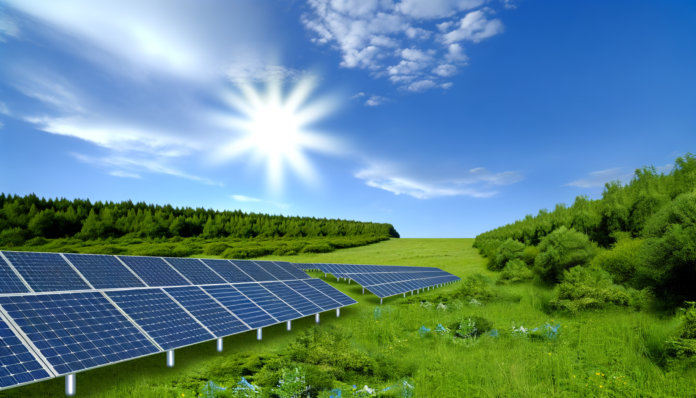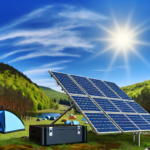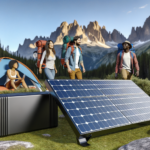Introduction to Solar Investments in the Wild
The Growing Popularity of Solar Power
In recent years, solar power has surged in popularity, becoming a cornerstone of the global shift towards renewable energy. This rise can be attributed to several factors, including technological advancements, decreasing costs, and increased awareness of environmental issues. Solar energy is now more accessible and affordable than ever, making it an attractive option for both residential and commercial use. The global solar market has seen exponential growth, with installations increasing year over year, driven by both government incentives and private sector investments.
Why Solar Power is Ideal for Outdoor Enthusiasts
For outdoor enthusiasts, solar power offers a unique blend of practicality and sustainability. Whether you’re camping, hiking, or living off-grid, solar energy provides a reliable and eco-friendly power source. Portable solar panels and solar-powered devices have revolutionized the way adventurers interact with nature, allowing them to stay connected and powered up without relying on traditional energy sources. Solar power is particularly advantageous in remote areas where access to the electrical grid is limited or non-existent. It enables outdoor lovers to enjoy their activities with minimal environmental impact, aligning perfectly with the ethos of preserving natural landscapes.
Purpose and Scope of the Article
This article aims to explore the multifaceted benefits of solar investments, particularly in outdoor settings. We will delve into the technological aspects of solar energy, examining the different types of solar panels and their applications. The economic advantages, including initial costs, long-term savings, and government incentives, will be thoroughly discussed. Additionally, we will highlight the environmental impact of solar power, comparing it to other renewable energy sources. Practical applications for camping, off-grid living, and emergency preparedness will be showcased, providing readers with actionable insights. Finally, we will guide you through choosing the right solar equipment and look at future trends in solar technology. By the end of this article, you will have a comprehensive understanding of how solar investments can enhance your outdoor experiences while contributing to a sustainable future.
Understanding Solar Technology
Basic Principles of Solar Energy
Solar energy harnesses the power of the sun to generate electricity or heat. At its core, this technology relies on photovoltaic (PV) cells, which are made from semiconductor materials like silicon. When sunlight hits these cells, it excites electrons, creating an electric current. This process, known as the photovoltaic effect, is the foundation of solar power generation. Solar energy is not only abundant but also a clean and renewable source of power, making it an ideal choice for sustainable living.
Types of Solar Panels and Their Applications
There are several types of solar panels, each with its own set of advantages and applications:
- Monocrystalline Solar Panels: These panels are made from a single crystal structure, offering high efficiency and longevity. They are ideal for residential and commercial installations where space is limited but high efficiency is required.
- Polycrystalline Solar Panels: Made from multiple silicon crystals, these panels are generally less efficient than monocrystalline panels but are more cost-effective. They are suitable for larger installations where space is not a constraint.
- Thin-Film Solar Panels: These panels are made by depositing one or more layers of photovoltaic material onto a substrate. They are lightweight and flexible, making them ideal for applications like building-integrated photovoltaics (BIPV) and portable solar devices.
Each type of panel has its own set of pros and cons, and the choice often depends on the specific needs and constraints of the installation site.
Portable vs. Fixed Solar Solutions
Solar technology can be broadly categorized into portable and fixed solutions, each serving different needs and applications.
Portable Solar Solutions:
Portable solar solutions are designed for mobility and ease of use. They are perfect for outdoor enthusiasts, campers, and emergency preparedness. These systems often include foldable solar panels, solar chargers, and portable power stations. Their lightweight and compact design make them easy to transport and set up, providing a reliable source of power in remote locations.
Fixed Solar Solutions:
Fixed solar solutions are permanent installations typically found on rooftops, ground-mounted systems, or integrated into building structures. These systems are designed for long-term use and are capable of generating significant amounts of electricity. Fixed solar installations are ideal for residential, commercial, and industrial applications where consistent and substantial power generation is required.
In summary, understanding the basic principles of solar energy, the types of solar panels available, and the differences between portable and fixed solar solutions can help you make informed decisions about investing in solar technology. Whether you’re looking to power your home, business, or outdoor adventures, there’s a solar solution that fits your needs.
Economic Benefits of Solar Investments
Initial Costs and Long-Term Savings
Investing in solar power can seem daunting due to the initial costs, but the long-term savings make it a financially sound decision. The upfront expenses include the cost of solar panels, installation, and any additional equipment like inverters and batteries. On average, a residential solar panel system can cost between $15,000 and $25,000 before any incentives or rebates. However, these costs are often offset by significant savings on electricity bills.
Once installed, solar panels can drastically reduce or even eliminate your electricity costs. For instance, if you spend around $1,500 annually on electricity, a solar panel system can save you approximately $30,000 over 20 years, assuming electricity rates remain constant. Moreover, solar panels have a lifespan of 25-30 years, ensuring long-term savings well beyond the initial payback period.
Return on Investment (ROI) for Solar Power
The Return on Investment (ROI) for solar power is a critical factor for many potential investors. ROI is calculated by dividing the net profit from the solar investment by the initial cost. For example, if your solar system costs $20,000 and saves you $1,500 annually, your payback period would be around 13-14 years. After this period, the savings translate directly into profit.
Solar panels typically offer an ROI of 10-20%, which is competitive with other investment options like stocks or real estate. Additionally, the ROI can be higher in areas with higher electricity rates or more sunlight. The performance of solar panels does degrade over time, but this is usually a gradual process, with most panels retaining around 80% of their efficiency after 25 years.
Government Incentives and Tax Benefits
Government incentives and tax benefits significantly enhance the economic viability of solar investments. In the United States, the federal government offers a Solar Investment Tax Credit (ITC), which allows you to deduct 30% of the cost of installing a solar energy system from your federal taxes. This incentive can reduce the initial cost of a $20,000 system to $14,000, making the investment more affordable.
Many states and local governments also offer additional incentives, such as rebates, property tax exemptions, and performance-based incentives. These can further reduce the cost and improve the ROI of your solar investment. For example, some states offer rebates that can cover up to 20% of the installation costs, while others provide performance-based incentives that pay you for the electricity your system generates.
In summary, while the initial costs of solar investments can be high, the long-term savings, attractive ROI, and substantial government incentives make it a financially sound decision. By investing in solar power, you not only contribute to a sustainable future but also enjoy significant economic benefits.
Environmental Impact of Solar Power
Reducing Carbon Footprint
Solar power is a pivotal player in the fight against climate change, primarily due to its ability to significantly reduce carbon footprints. Unlike fossil fuels, solar energy generation does not produce greenhouse gases during operation. However, it’s important to note that there are emissions associated with other stages of the solar lifecycle, including manufacturing, transportation, installation, maintenance, and decommissioning. Despite these factors, the lifecycle emissions for photovoltaic systems are estimated to be between 0.07 and 0.18 pounds of CO2 equivalent per kilowatt-hour, which is substantially lower than those for natural gas (0.6-2 lbs CO2e/kWh) and coal (1.4-3.6 lbs CO2e/kWh).
The reduction in carbon emissions is not just theoretical. Real-world applications have shown that solar panels can offset the carbon used in their production within a few years of operation. This makes solar power a highly effective tool for reducing overall carbon emissions and combating global warming.
Sustainability and Renewable Energy
Solar energy is a cornerstone of sustainable living. As a renewable resource, it harnesses the sun’s power, which is abundant and inexhaustible. This contrasts sharply with fossil fuels, which are finite and contribute to environmental degradation. Solar power systems, particularly when integrated with energy storage solutions, can provide a reliable and sustainable energy supply.
Moreover, solar energy systems can be designed to coexist with natural ecosystems. For instance, ground-mounted solar panels can be installed in ways that minimize land use impacts, such as on rooftops or over parking lots. Additionally, solar farms can be integrated with agricultural activities, a practice known as agrivoltaics, which allows for dual land use and enhances the sustainability of both energy and food production.
Comparing Solar to Other Renewable Sources
When comparing solar power to other renewable energy sources, several factors come into play, including efficiency, environmental impact, and scalability. Wind and hydroelectric power are also significant renewable energy sources, each with its own set of advantages and challenges.
**Wind Power:** Wind turbines generate electricity without emitting greenhouse gases during operation. However, they require significant land and can impact local wildlife, particularly birds and bats. Wind energy is also location-dependent, requiring areas with consistent wind patterns.
**Hydroelectric Power:** Hydropower is a well-established renewable energy source that can provide large amounts of electricity. However, it often involves damming rivers, which can have significant ecological impacts, including altering water ecosystems and displacing communities.
**Solar Power:** Solar energy stands out for its versatility and minimal environmental impact during operation. Solar panels can be installed on various scales, from small residential rooftops to large solar farms. They also have fewer impacts on local wildlife compared to wind and hydroelectric power. However, the efficiency of solar panels can be affected by geographic location and weather conditions.
In conclusion, while each renewable energy source has its strengths and weaknesses, solar power offers a unique combination of low environmental impact, scalability, and sustainability. Its ability to reduce carbon footprints and integrate seamlessly into various environments makes it a vital component of the global transition to renewable energy.
Practical Applications of Solar Power in the Wild
Solar Power for Camping and Hiking
For outdoor enthusiasts, solar power offers a reliable and eco-friendly energy solution. **Portable solar panels** and **solar chargers** have become essential gear for campers and hikers. These devices can power essential gadgets like GPS units, smartphones, and even small cooking appliances. The convenience of having a renewable energy source in remote locations cannot be overstated.
– **Portable Solar Panels**: Lightweight and foldable, these panels can be easily packed and set up at campsites. They can charge multiple devices simultaneously, ensuring that you stay connected and safe.
– **Solar Chargers**: Compact and efficient, solar chargers are perfect for day hikes. They can be attached to backpacks, allowing you to charge your devices as you walk.
The use of solar power in camping and hiking not only reduces the need to carry extra batteries but also minimizes the environmental impact, aligning with the principles of Leave No Trace.
Using Solar Energy for Off-Grid Living
For those who choose to live off the grid, solar energy is a game-changer. It provides a sustainable and independent power source, reducing reliance on traditional energy grids. **Off-grid solar systems** typically include solar panels, batteries, and inverters to store and convert solar energy for household use.
– **Solar Panels**: These are installed on rooftops or open land to capture sunlight. High-efficiency panels can generate significant power even in less sunny conditions.
– **Battery Storage**: Essential for storing excess energy generated during the day, batteries ensure a continuous power supply during the night or cloudy days.
– **Inverters**: These convert the stored solar energy into usable electricity for household appliances.
Living off-grid with solar power not only cuts down on utility bills but also promotes a sustainable lifestyle. It allows individuals to live in harmony with nature while enjoying modern conveniences.
Solar Solutions for Emergency Preparedness
In emergency situations, such as natural disasters, having a reliable power source is crucial. Solar power provides a dependable solution when traditional power grids fail. **Solar generators** and **emergency solar kits** are becoming increasingly popular for emergency preparedness.
– **Solar Generators**: These portable units can power essential devices like medical equipment, communication tools, and lighting. They are easy to set up and can be recharged using solar panels.
– **Emergency Solar Kits**: These kits typically include solar panels, batteries, and essential accessories. They are designed to be quickly deployed in emergency situations, providing immediate power.
Solar solutions for emergency preparedness ensure that you are not left in the dark during critical times. They offer peace of mind and a sustainable way to manage power needs during emergencies.
In conclusion, the practical applications of solar power in the wild are vast and varied. From enhancing outdoor adventures to supporting off-grid living and providing emergency power, solar energy proves to be a versatile and sustainable solution. Embracing solar technology not only benefits individuals but also contributes to a greener and more resilient planet.
Choosing the Right Solar Equipment
Factors to Consider When Buying Solar Panels
When investing in solar panels, several critical factors should guide your decision-making process. First and foremost, consider the **efficiency** of the panels. High-efficiency panels, such as monocrystalline panels, convert more sunlight into electricity, making them ideal for areas with limited space. **Durability** is another key factor; panels should be able to withstand various weather conditions, from intense sunlight to heavy snow. Look for panels with robust warranties, often up to 25 years, which can provide peace of mind regarding their longevity.
**Cost** is also a significant consideration. While high-efficiency panels may have a higher upfront cost, they often offer better long-term savings. Additionally, consider the **manufacturer’s reputation**. Brands like Rich Solar are known for their quality and reliability, which can be crucial for long-term investments. Lastly, check for **certifications** and **compliance** with local regulations to ensure your panels meet safety and performance standards.
Top Features to Look for in Portable Solar Devices
Portable solar devices are a boon for outdoor enthusiasts and those needing a reliable power source on the go. When selecting portable solar equipment, prioritize **portability** and **weight**. Lightweight and compact designs are easier to carry and set up. **Power output** is another crucial feature; ensure the device can generate enough power to meet your needs, whether it’s charging a smartphone or running a small appliance.
**Durability** is essential for portable devices, which are often exposed to harsh outdoor conditions. Look for features like **waterproofing** and **shock resistance**. **Ease of use** is also important; devices with intuitive interfaces and quick setup times are more convenient. Additionally, consider **battery capacity** and **charging speed**. Some portable solar devices come with built-in batteries, allowing you to store energy for use when the sun isn’t shining. Lastly, check for **additional features** like multiple charging ports, which can enhance the device’s versatility.
Maintenance and Care for Solar Equipment
Proper maintenance and care are vital to ensure the longevity and efficiency of your solar equipment. Regular **cleaning** is essential, as dirt, dust, and debris can significantly reduce the panels’ efficiency. Use a soft brush or a cloth with water to clean the surface gently. Avoid using abrasive materials or harsh chemicals that could damage the panels.
**Inspection** is another critical aspect of maintenance. Periodically check for any signs of wear and tear, such as cracks or loose connections. Ensure that the mounting system is secure and that there are no obstructions blocking sunlight from reaching the panels. For portable devices, inspect the cables and connectors for any damage.
**Professional servicing** can also be beneficial. While solar panels require minimal maintenance, having a professional inspect your system annually can help identify and address potential issues before they become significant problems. Additionally, ensure that your system’s **inverter** and **battery storage** (if applicable) are functioning correctly, as these components are crucial for converting and storing solar energy.
By considering these factors and maintaining your equipment properly, you can maximize the efficiency and lifespan of your solar investment, ensuring that it continues to provide sustainable energy for years to come.
Future Trends in Solar Technology
Innovations in Solar Panel Efficiency
The quest for higher efficiency in solar panels is a driving force in the renewable energy sector. Recent advancements have led to the development of multi-junction solar cells, which layer multiple semiconductor materials to capture a broader spectrum of sunlight. This technology has pushed efficiency rates beyond 40%, a significant leap from the 15-20% efficiency of traditional silicon-based panels.
Another promising innovation is the use of perovskite materials. These materials are not only cheaper to produce but also offer high efficiency and flexibility. Researchers are working on hybrid solar cells that combine perovskite with silicon, aiming to surpass the efficiency limits of current technologies. Additionally, the integration of nanotechnology, such as quantum dots and nanowires, is being explored to further enhance light absorption and conversion efficiency.
Emerging Portable Solar Technologies
The demand for portable solar solutions is growing, especially among outdoor enthusiasts and those living in remote areas. Innovations in this space include foldable and rollable solar panels, which offer convenience and ease of transport. These panels are made from lightweight, flexible materials that can be easily packed and deployed.
Solar backpacks and chargers are also gaining popularity. These devices integrate small solar panels into everyday items, allowing users to charge their gadgets on the go. Advances in battery technology, particularly in lithium-ion and solid-state batteries, are enhancing the storage capacity and lifespan of these portable solar solutions.
Moreover, solar-powered tents and shelters are being developed for use in disaster relief and military operations. These structures come equipped with integrated solar panels and energy storage systems, providing a reliable power source in emergency situations.
The Role of Solar Power in Sustainable Living
Solar power is increasingly seen as a cornerstone of sustainable living. Beyond reducing carbon footprints, solar energy offers a pathway to energy independence and resilience. Community solar projects are emerging as a viable option for those who cannot install panels on their own properties. These projects allow multiple households to share the benefits of a single solar installation, making renewable energy more accessible and affordable.
In urban settings, building-integrated photovoltaics (BIPV) are transforming the way we think about solar energy. BIPV systems integrate solar panels into the architecture of buildings, such as rooftops, facades, and windows. This not only generates clean energy but also enhances the aesthetic appeal and functionality of structures.
Agrivoltaics, the practice of combining agriculture with solar power, is another innovative approach. By installing solar panels above crops, farmers can generate electricity while protecting their plants from extreme weather conditions. This dual-use strategy maximizes land efficiency and provides additional income streams for farmers.
In conclusion, the future of solar technology is bright, with continuous innovations driving efficiency, portability, and integration into various aspects of daily life. As these technologies evolve, they will play a crucial role in promoting sustainable living and addressing global energy challenges.






